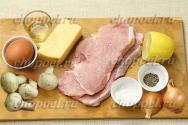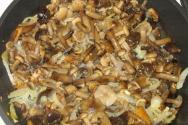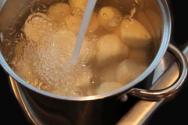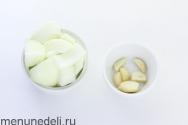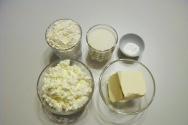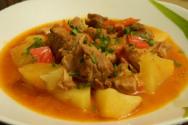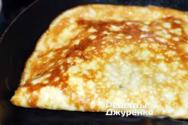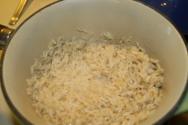Easter cakes the easy way. How to bake Easter cake - recipes for Easter. How to make icing from proteins and sugar syrup
Kulich is a primordially Russian national dish that everyone cooks once a year on Easter. Dough for Easter cake is made differently in different families. Someone puts dough on kefir, someone adds cinnamon or vanilla, and someone prefers to enjoy the lemon flavor that citrus zest gives to pastries. But before you start cooking this rich Easter dish, you should find out why our ancestors loved it so much.

The history of the Easter cake
Kulich is a truly Christian dish, although the first mention of this muffin belongs to the ancient Slavs. With the advent of Orthodoxy, Easter cakes began to be baked for the Easter holiday, and this pastry personified church bread.
Nevertheless, certain superstitions regarding the preparation of Easter cakes have survived in Christian society. So, it used to be considered a good omen to lay out pieces of consecrated pastry in the field. The farmers believed that this would contribute to a rich harvest. But if the crust of the Easter cake cracked during baking - expect trouble.
Everyone decides for himself whether or not to believe Easter superstitions (although the Church does not welcome such signs), and cakes are baked as they were baked on the spring Easter holiday, except that the recipe has changed a little.
There are currently many different recipes dough for Easter muffin. Consider the most delicious of them.

Viennese dough for Easter cakes
Viennese dough for Easter cakes is classic recipe Easter cake. This is how most muffins are prepared for Easter. Such a dough for Easter cake has rich taste, it does not become stale for a long time.
Ingredients:
- Flour - 6 glasses;
- Milk - 2 cups;
- Butter -1.5 - 2 packs;
- Sugar -2 cups;
- Eggs - 6 pieces;
- Yeast - 50 grams;
- Salt - 1 teaspoon:
- Raisins (the classic recipe calls for raisins, but you can add whatever you like).
Cooking process:
- First of all, you need to prepare the dough. To do this, combine eggs and sugar, beat thoroughly, pour melted butter and warm milk with yeast diluted in it into the mixture. Mix everything well and put it to the battery to “rise”.
- Important point! The dough for Viennese Easter cakes should stand for a long time - ideally the whole night.
- When the dough "fits", add the sifted flour to it and knead the dough. You need to knead until the dough stops sticking to your hands.
- In the middle of the process, you can add raisins, dried apricots or other additives to your taste into the semi-finished dough.
- When the dough is ready, it should be placed in a mold (or molds) and left warm for 2 hours.
- You can bake Easter cake when the dough increases in volume, becomes lush and airy.
The baking time of the Viennese cake depends on the volume of the form. If you are baking one large muffin, then you need to spend at least 50-60 minutes in the oven. If the Easter cakes are small - 30-40 minutes.
Check the readiness of Easter cakes constantly with a match or a toothpick and do not miss the moment when the dessert is baked.
This recipe is the most popular; it has been used to prepare the most famous Easter dish for more than a dozen years. However, feel free to make your own changes to the recipe and experiment with additives.

Easter cake without yeast
Everyone knows that our ancestors did not have yeast, so they made bread with hop or wheat sourdough. But there is no need to delve into history and look for a sourdough recipe to make a yeast-free cake. Currently, you can cook baking without yeast on soda. By the way, such a muffin will be much more useful than simple yeast dough for cakes.
Ingredients:
- Flour - 1.5 cups;
- Kefir - 1.5 cups;
- Butter - 1 pack;
- Baking soda - 1 teaspoon;
- Sugar - 0.5 cups;
- Any additions to your own taste.
The amount of sugar can be increased depending on how sweet the muffin you want to bake.
Cooking process:
- Prepare all food and utensils for work.
- Sift the flour through a sieve, add soda to kefir and let the mixture brew for a couple of minutes.
- Melt the butter in a water bath, stir in sugar and additives (optional).
- Next, add kefir to the butter-sugar mixture and mix the resulting dough well.
- Flour is added last and the dough is thoroughly mixed again.
- If the dough for Easter cake turns out to be very liquid, add a few more tablespoons of flour.
This dough is good because its preparation does not take much time. Unlike a yeast cake, a yeast-free analogue can be immediately put into the oven. Such Easter cakes are prepared for 30-40 minutes (readiness must be checked with a toothpick).

Dough for Easter cake without eggs
This recipe will definitely appeal to vegetarians and those who are allergic to eggs.
Ingredients:
- Water or milk - 1 glass;
- Sugar - 1 glass;
- Flour - 4 - 4.5 cups;
- Butter - 1 pack;
- Sour cream - 0.5 cups;
- Yeast - 50 grams;
- Salt - 0.5 tablespoons;
- Lemon zest, raisins, chocolate or other additives to taste.
Cooking process:
- Slightly heat water or milk and pour into its yeast. Stir so that there are no lumps, and then add 2 tablespoons of sugar and a handful of flour. Opara is ready - leave it to "approach" in a warm, calm place for 15-30 minutes.
- At this time, melt the butter (you can use a water bath) and mix it with sour cream.
- Next, add the butter to the butter. This must be done carefully, and stir slowly and carefully.
- In the resulting mixture, add sugar, salt, additives and mix thoroughly.
- The last one is flour. It is first recommended to sift it and add it in small portions to the resulting mixture.
- Next, you need to knead everything well. (Don't forget to wet your hands vegetable oil so that the dough doesn't stick!
- Put the finished dough in a warm oven or to the battery and let it rise twice. Only after that you can start baking Easter cake.

Additives for dough
Just dough for Easter cake is boring, but on Easter you really want joy! In order to “colorize” the Bright Spring Festival even more, you can show your imagination and bake Easter cakes with various additives.
What can be added to the dough:
- 1.Dried fruits
The most common additive is, of course, raisins, but other dried fruits can also be added: dried apricots, dates, prunes, dried apples. Even if the recipe does not include the addition of dried fruits, they will never be superfluous.
- 2. Candied fruits
These multi-colored dried fruits will not only make the dough more delicious, but also give the Easter cake a joyful festive look.
- 3. Nuts
Any will do - cashews, walnuts, almonds, cedar. Large nuts are recommended to cut or grind in advance in a coffee grinder.
- 4.Chocolate
Pastry shops sell special chocolate "drops" to decorate baked goods, but you can add regular chopped chocolate.
- 5. Zest of a lemon or orange
It will give the cake an unusually fresh citrus flavor. In addition to the zest, you can add a little lemon juice to the dough - it will make the dough softer and softer.
- 6. Spices
You can add vanilla extract or cinnamon powder to the recipe. Cardamom and nutmeg will add a savory taste to pastries, while saffron will color the dough in sunny yellow.
- 7. Confectionery additives
Coconut flakes, multi-colored powders, marzipan - the modern confectionery industry generously endows us with its inventions. The dough for Easter cakes can not only be decorated, but also dyed with special food coloring!
Cooking Easter cake with your own hands and treating them to relatives and friends is a real happiness! And it depends only on you how tasty, beautiful and festive your pastries will be. Don't be afraid and experiment! Delight your family and friends with delicious dishes.
It is difficult with Easter cakes, we bake them once a year. Therefore, when we bake, we draw conclusions from our mistakes, but after a year we forget them. That is, it does not work, as they say, to fill your hand. And that's why you must have a good proven recipe in service. A recipe for which the cake is guaranteed to turn out.
This recipe was shown to us. Sergey Sinitsyn, chef of the restaurant "Kompot":
Molds. We bake Easter cakes in cans of condensed milk. It turns out mini-cakes, for 1 serving. I do not think that there is any danger in these jars when heated, but we cook condensed milk in them. And this temperature, though lower, but not by much.
To prevent cakes from burning, we put baking paper in jars.
Yeast. I only work with dry ones. But when I worked at a bakery, it was about 12 years ago, they used pressed yeast. They are very fragrant. Huge briquettes were brought to us, and one such piece gave a smell to the whole workshop. But such yeast lasts longer than dry yeast.
Butter. It must be very good and high quality. Room temperature. The oil should be very soft.
Honey. Used together with sugar, honey gives a great flavor. Well, it's still healthier than sugar.
For 4 small cookies
Ingredients:

Photo: AiF / Alexey Vissarionov
For dough:
- 80 ml warm milk
- 7 g dry yeast
- 1 st. l. honey,
- 60 g flour.
For the test:
- 350 g flour
- 120 g butter,
- 3 eggs,
- 50 g sugar
- 1 tsp salt,
- vanilla,
- 70 g raisins,
- 1 yolk for brushing.
Cooking dough. Stir yeast and honey in warm milk. And slowly add flour to the liquid. Which we have previously sifted.
Advice: it is necessary to sift the flour, in the process of sifting the flour is saturated with oxygen and rises better, the product is lighter.
Wait. The dough is placed in a warm place, covered with cling film. You can put it on the stove or on the battery. But don't put it where it's too hot. Yeast at temperatures above 40 degrees may die.
Making dough. Add the ingredients for the dough to the approached dough. First liquid, and at the very end - flour. Don't forget to lightly salt the dough.
knead the dough. You need to knead the dough so that the dough sticks to your hands, but it should not be steep. It is best to knead with your hands. A small amount we will not knead for very long.Wait. Again, leave for 30-40 minutes. And wait until the dough doubles in size.
Knead. In a good way, after the dough has come up, you need to knead it and leave it to come up again. Then the dough will turn out more tender, better. But it is clear that there is not always enough time for this. This step is often skipped.
Sort into shapes. We prepared them in advance, lined them with parchment. We lay the dough so that it is slightly less than half in shape, because it needs a place to rise.
Still wait. If the second time they didn’t crush and didn’t let them come up, then after laying out the forms, definitely leave the future Easter cakes to stand for a bit. They should come up a little. Then you can bake.
Baking. The temperature regime must be observed very carefully. Do not bake at too high a temperature, otherwise the cakes may fall off. We set 170 degrees - this is optimal. Yeast is very sensitive to temperature. And do not open the oven door during baking.
Such small cakes are baked for about 30-40 minutes.
In the process of baking, when the top of the cake is already set, you can grease it with yolk.
Get Easter cake. Kulich needs to cool in the form, and then take it out. Just when it cools down, it will shrink a little in size, and it will be easy to take it out.
Decoration. Can be sprinkled with powdered sugar. You can also make frosting on the top. The simplest: protein, sugar, a few drops of lemon juice. And beat everything very well. If you add a little juice, orange or cherry, to this glaze, you will get multi-colored Easter cakes. They are very popular with children.
Kulich is an image of the Resurrection or the victory of Christ over death, and is similar to artos (large church bread with a cross and a wreath of thorns depicted on it). Only unlike artos, Easter cake is prepared at home.
Usually the dough for Easter cakes is put from Thursday to Friday, they are engaged in baking all Friday, and on the night before Sunday they consecrate. But, unfortunately, in our time of constant employment, not every housewife can afford to take this process for several days. And, of course, you want to spend the holiday according to all the rules. This is where a simple cookie recipe comes in handy.
The main thing, using do not forget about several rules, so it has its own characteristics:
During the preparation of dough for Easter cakes, it is necessary to ensure that there is no draft in the room - Easter cakes are very fond of heat
The dough for Easter cake should be of medium density, if the dough is too liquid - Easter cakes will become flat after baking, if it is thick - baking will be heavy and stale very quickly. The required density will be when, when dividing the dough, there will be no need to add flour
You need to knead the dough for as long as possible, putting all your love into it, wishing good to family and friends
The dough should rise three times: 1. after dissolving, 2. after kneading, 3. after the dough is distributed into molds
The dough should ferment at a temperature of 30 degrees
It is necessary to fill the form by half, and in some cases by 2/3
Easter cakes should rise indoors, the temperature in which will be from 30 to 45 degrees
If the dough has risen almost to the edges of the mold, you can put it in the oven
You need to bake in the oven, at the bottom of which a container of water is placed. Oven temperature from 200 to 240 degrees
After baking, the bread is smeared with an egg, which is beaten with a tablespoon of water and butter. Sprinkle with coarse sugar, breadcrumbs and chopped nuts on top.
The secret of an even high product is a wooden stick (long match) in the center. And also this is a way to check the cake for readiness: if the pulled out stick (match) is dry, your cake is ready!
The size of the cake affects the duration of baking. The more the weight of the cake, the longer you need to keep it in the oven, and accordingly, the less the weight, the less time it takes to cook. If the cake starts to burn, cover the top with paper
Easter cake taken out of the oven must be put on a barrel and wait until it cools down
Easy cake recipe
Ingredients:
Measure - glass
Flour - 7.5
Milk - 2, 5
Yeast - 1 sachet (50 gr)
twenty egg yolks
Sugar - 1
Butter (melted) - 2
Cooking method:
Mix flour and milk. Dilute the yeast in a small amount of milk and add to the flour mixture. We put everything in a warm place. Grind the egg yolks with sugar and warm milk, add to the risen dough, then add the remaining flour and salt. Knead the dough well and leave to rise.
After the dough has risen, divide it and put it into molds. After the dough has risen in the molds, put it in the oven and bake.
If there is not enough time at all, then you can use a modern bread baking tool - a bread machine, and then, in order to bake a delicious and quick cake, you will have to spend only a little effort on preparing the ingredients for the dough.
A simple recipe for a bread maker
Ingredients:
Yeast - 15 grams
Flour - 450 grams
Sugar - 6 tablespoons
Vanillin - one sachet
Butter - 2 tablespoons (tablespoons)
Eggs - 3 pieces
Milk - 150 ml
Raisins - 100 grams
Turmeric - ½ teaspoon
Cooking method:
Prepare the raisins in advance by boiling them for 10-15 minutes. Melt butter in warmed milk, then cool. Send all the ingredients, except for the raisins, to the bread machine in the order indicated in the recipe. Raisins must be placed in the bread machine after fifteen minutes of kneading. Next, put the program "Sweet bread", or "Basic with raisins" and that's it! Now it remains to wait until the work of the machine is finished, and enjoy the wonderful and delicious Easter cake!
It is not only Easter, but also the illuminated Easter cake. Quite often, in the old days, a lot of dough was prepared for Easter cakes, since the dough for Easter cakes is better fermented in larger volumes. But unlike the usual dough for pies, where culinary specialists do not recommend laying eggs, in spite of everything, from 5 to 7 eggs are placed in real cake dough, beaten before mixing into foam. The basis of the products is a high protein content, a lot of butter and a large amount of sugar.
These components will allow any cook to get what they need, and ready-made eggs only last longer with an increase in the number of eggs, while almost not stale. About that, a large number of different recipes have been created, and on the Internet you can always find a huge one. But all the culinary specialists agree in one opinion - not only the content, but also the form is important for Easter cake. It is worth noting that the forms for Easter cakes can be completely different.
Since most often a soft cake is prepared from yeast dough, then the yeast must be necessarily only fresh, and it is not recommended to immediately overload the dough with baking. That is why Easter cake dough is prepared in several steps at once, which are classified into a gradual introduction of butter, then a large amount of eggs, and finally sugar. You will have to nurse and cherish the dough for a very long time. In addition, chefs recommend not exposing the dough for Easter cakes to drafts, but it is best to put it in a warm, dark place and wrap it with pillows.
As a rule, after a person has learned an easy recipe for Easter cakes, he does not think about the future taste and does everything at once. But the dough for Easter cakes must be kneaded on the night of Thursday to Friday, so that the whole next day you can bake Easter cakes from it. Usually, on the night from Saturday to Sunday, Easter cakes are consecrated, and they treat each other only in the morning. Easter cakes can be eaten throughout the Easter week, right up to Radonitsa. When baking Easter cakes, it is necessary to use special metal low cylindrical molds made of universal thick tin. Thus, having moistened the inner surface with oil, it will not be difficult to cook a delicious cake.
You can also use ordinary metal aluminum pans with a total volume of 1-1.5 liters, but no more. If you use higher and more voluminous dishes during cooking, then in a gas and electric stove such a dough can not only not be baked, but also become damp or dry. In the old days, small Easter cakes were often made in special bucket forms. Easter cakes were quickly baked in them, almost the same as in a Russian oven. Below is an easy recipe for Easter cakes, time-tested.
Easy cake recipe
To prepare this dish, we need 1 kg of high-quality flour, 2 cups of fresh milk, 5-6 chicken eggs, 500 g of butter, about 3 cups of sugar and 200 g of yeast. For decoration we use candied fruit and vanilla.
First you need to knead the dough. To do this, we begin to dissolve the yeast in warm milk, and at the same time add a pound of flour. Cover this batch and put it in a warm place for about an hour. Then add the yolks, which are pre-whipped with sugar, and a small amount of vanillin. After that, gradually pour in the melted butter and gradually mix everything.
When the dough begins to rise, you need to put washed and dried candied fruits and nuts into the dough, and mix everything thoroughly. The dough is laid out in forms, and the dough is placed in a hot oven at a temperature of 300-300 degrees for an hour. After that, it remains only to look after him and decorate the dish after cooking.
I hope that after my article you understand how to cook this dish using an easy recipe for Easter cakes.
1. Let's say right away that everything, or almost everything, depends on the dough, or rather, on its quality. You should start by heating milk in a saucepan to 30 degrees. If you don’t have a thermometer at hand, you can immerse a clean one in it! finger and focus on such sensations - cold milk has a temperature of 15-20 degrees, if there is no difference, then it is about 26-32, if warm, then above forty.

2. Add sugar to the milk (literally one or two tablespoons and about 1/3 of the total amount of flour), pour the yeast, mix thoroughly and let it brew. If everything is done correctly, the volume of the dough should approximately double in size, and it will take about 40-45 minutes.

3. Now melt the butter and cool it a little, add the rest of the sugar, salt, vanillin to the dough, beat in the eggs and pour in the butter.

Slowly add most of the remaining flour dough after kneading and knead the dough. Gradually add flour little by little. Don't forget to stir. The dough for Easter cakes should hold its shape and not be fluid, but also not turn into a hard lump.

4. Leave the mass in a warm place for another 45 minutes so that the dough rises well.
5. We wash the raisins, pour hot water for a few minutes to soften them. After the water must be drained, rinse the berries and squeeze lightly.

6. Add pure raisins to the risen dough and knead so that it is evenly distributed.

It remains to lay out the dough in forms. They should be 1/2 or 2/3 full.
7. Forms with dough for Easter cakes are also left to stand for 35 - 40 minutes.

8. After that, preheat the oven to 180 degrees. We place the future Easter cakes in the oven and cook for about 45 - 50 minutes.
If the top begins to darken, you need to cover the cakes with parchment soaked in water.
9. We take out the finished cakes from the oven, leave for 30 minutes and start decorating. For this, the simplest glaze is suitable. To prepare it, you need to dilute three tablespoons of powdered sugar in a tablespoon of warm milk, stir until smooth, brush the top of the cakes with a brush and leave to harden.

That's all, it remains only to decorate the Easter cake with powders, which are sold in a large assortment in stores.

This amount of dough will make quite a lot of Easter cakes. Everything, of course, depends on the diameter of the mold. We got three 15 cm in volume and four 10 cm each.
I have been baking Easter cakes according to this recipe for many, many years, so who else doubts and is in search delicious pastries for Easter, I tell you: bake this delicious simple cake and you will not regret it. The recipe is very simple!
Bon appetit and Happy Easter!
Sincerely, Natalia Salmina.
Step by step recipe with a photo specially for the site Well-fed family.

